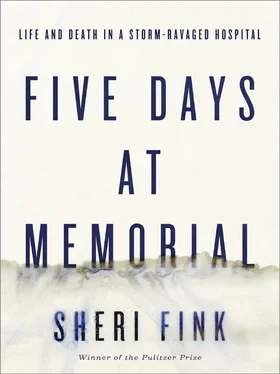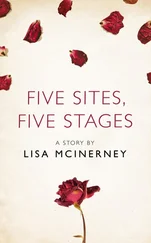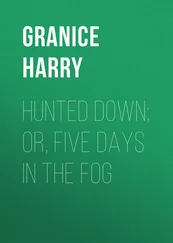On January 15, 2005, Pou attended an annual banquet at the RitzCarlton in New Orleans to celebrate the installation of Memorial Medical Center’s elected medical staff leaders. The festivities took place under crystal chandeliers. The Blackened Blues Band belted out rock, blues, and soul music. Giant trays of oysters and shrimp balanced on the banquet table beside bouquets bursting with lilies, birds-of-paradise, and irises. Dessert tables adorned with Mardi Gras beads, masks, and candles held trays laden with tarts.
Pou wore a short-sleeved pantsuit with a double strand of pearls and pearl drop earrings and a sleek, chin-length hairstyle. She spent the evening socializing with other members of the medical staff and their spouses, flashing her broad, toothy smile for the event photographer.
The doctors’ lavish party contrasted with the troubled state of Memorial’s parent company, Tenet Healthcare, which owed hundreds of millions of dollars in fees and settlements for allegations of fraud and unnecessary surgeries at other hospitals. Tenet faced falling stock prices, multibillion-dollar operating losses, a federal lawsuit for overbilling Medicare to inflate revenues, and a class-action lawsuit by shareholders for allegedly having misled investors. As part of an aggressive shift away from this troubled history, Tenet had moved its corporate headquarters from California to the Gulf South in Dallas, and was in the process of selling twenty-seven hospitals that weren’t meeting financial goals.
The doctors affiliated with Memorial followed the news, but they still had much to celebrate. Only three years after the hospital’s new surgery center opened, executives had recently cut the ribbon on a new, $18 million cancer institute across the street from the main hospital. They had also completed a $5 million renovation of the labor and delivery center. Memorial had passed a midterm hospital accreditation survey, and it boasted some of the highest employee satisfaction rankings of any of Tenet’s dozens of hospitals in several states. For the staff at Memorial, the year 2005 looked bright.

POU HAPPENED TO BE on duty for her department when Katrina threatened, meaning she was expected to stay for the hurricane. Dr. Dan Nuss, the department chairman, called her, concerned. “I think this is the real thing,” he said. None of their postsurgical patients, spread over several area hospitals, were terribly sick. Nuss urged Pou to sign out the patients’ care to other doctors. Pou’s husband agreed. Two resident physicians were on call with Pou that weekend. She dismissed them so they could be with their families. “Leave town,” she advised them. At four p.m. on Sunday, the National Hurricane Center warned for the first time that battering waves and a mountain of water forced up by Katrina’s winds—towering as high as twenty-eight feet above normal tide level—could overtop some levees protecting the city. Pou had resolved to stay in case anyone trapped in the city needed the kind of specialized care she and few others could provide. Pou’s department did most of its roughly 1,000 surgeries a year at Memorial, and she decided to base herself there.
As the surgical staff hunkered down that Sunday evening, the endoscopy suite they had claimed for quarters took on the atmosphere of a slumber party. Many of the nurses and Pou were coevals. They had grown up in New Orleans, attended private and Catholic schools, and now, with time to talk, they found they had friends in common. The nurses knew Pou’s first serious boyfriend from his work as an anesthetist at Memorial. “If you saw him now!” they teased her. He was a sturdy man with playful eyes, apple cheeks, and a lopsided smile who now had a wife, three daughters, and a graying, receding hairline. Pou took out her lipstick and began applying it. “What are you doing?” a nurse asked her. “It’s midnight! What are you doing?”
Pou said she wanted to look her best in case she saw him. The nurses laughed and reassured her. He had recently left his job.
It was hot outside, but cold in the hospital; the plant operations team had lowered the thermostat to make the buildings extra cool while there was still city power. If the hurricane knocked out utilities, air-conditioning would be lost because the hospital’s backup power system wasn’t designed to run it. The nurses knew from previous experience it would heat up quickly. Pou made a few phone calls to friends and family. If anything bad happened, they could find her at the hospital, she said lightly. “What are you doing there?” a friend in Houston asked after watching the ominous weather forecasts. “Get out!” But Pou wasn’t changing her mind. “I’m going to stay,” she said.
As the storm approached, there were about 183 patients at Memorial—a little more than usual due to last-minute storm admittances—and nearly as many staff members’ pets. LifeCare-Baptist had an additional 55 patients, including the ones nursing director Gina Isbell had helped move from the St. Bernard campus. Around 600 staff members had arrived to provide care, along with hundreds of family members and companions. Memorial served a diverse clientele, a short drive to the genteel mansions of Uptown and a half-mile from a public housing project. Some community members had also come for shelter. Administrators tallied the census of humans in the medical center buildings at between 1,800 and 2,000.
Lightning flashed in the dark night. Rain rippled onto the road beneath the streetlights and beat against the windows with the undulations of the wind.
Pou did what came naturally and what she would do many times over the coming days. She prayed.
DAY TWO
MONDAY, AUGUST 29, 2005
2:11 A.M., WWL New Orleans Radio:
“Let’s go to Allen. Allen you’re on the sixth floor of Baptist Hospital? I bet those windows are doing a little shimmy shake right now, aren’t they?”
“Yes, sir, and I’ve been on patrol since around twelve forty five. It’s been a heck of a show…. We’ve had about three good squalls come through in that time.”…
“The windows are already doing the shimmy shake there on the sixth floor? You know the winds are much higher where you’re at than they are down at ground level.”
“Yeah. That’s one thing everybody in the hospital is really, really aware of. And, um, most of the patients who take critical care have been actually moved away from windows.”
“Any idea what those windows can take?”
“No. I’m not going to find out, either.”
“Well, we might. We might find out.”
The news announcers reported that three people had died on a bus on the long exodus from a New Orleans nursing home to a Baton Rouge church. Many of the survivors were dehydrated. Other details weren’t yet available.
Katrina shed some of its fury over the Gulf and spun north before beginning to envelop the coast in its massive grip. Area residents called in, concerned about what would happen over the coming hours. Would this be merely the worst storm they’d seen, the announcers asked, or would it cause a true worst-case scenario, with significant flooding? The National Guard was estimating that more than 25,000 people who wouldn’t or couldn’t leave New Orleans were packed into the Superdome. They were among those awaiting the answer.
4:30 A.M., FOURTH FLOOR, MEMORIAL MEDICAL CENTER
A LOUD CRACK startled Susan Mulderick awake, and she jumped up and ducked away from the floor-to-ceiling windows. She and her family members scrambled to gather their belongings and ran out of her office into the corridor. Mulderick’s seventy-six-year-old mother, a gray-haired widow in a billowy housedress, had never moved so quickly.
Читать дальше













